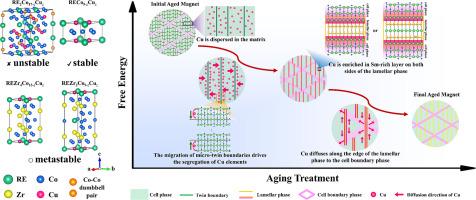Atomic-scale revelation of Cu diffusion mechanism in high-performance Pr-doped 2:17-type SmCo magnets
IF 8.3
1区 材料科学
Q1 MATERIALS SCIENCE, MULTIDISCIPLINARY
引用次数: 0
Abstract
The coercivity of 2:17-type SmCo magnets is mainly determined by the gradient distribution of Cu within the cell boundary phase. However, the fundamental migratory behavior and driving force causing such Cu distribution remains unclear. In this work, the phenomenon of Cu enrichment at the lamellar/intracellular interface is reported at the atomic scale, and a new Cu diffusion mechanism of 2:17-type SmCo magnets is proposed via combining microstructure characterization with first-principles calculation. Our study indicates that Cu will migrate from the intracellular phase to the lamellar/intracellular phase interface following the migration of twin boundary, and then diffuses further along the lamellar phase interface to the cell boundary, achieving the expected Cu-rich cell boundary structure. Doping Pr results in a reduction of Cu substitution energy in the lamellar phase, leading to a decreased driving force during the subsequent Cu diffusion. As a result, the Cu does not completely diffuse into the cell boundary phase there is Cu enrichment at the interface between lamellar and intracellular phases. The Cu concentration of the cell boundaries could be increased in 2:17-type SmCo magnets by reasonable designing the substitution energy difference of intracellular phase, lamellar phase and cell boundary phase that promote Cu diffusion to cell boundary. Our study sheds light on the control of Cu segregation in magnets and a new strategy for enhancing the magnetic performance of 2:17-type SmCo magnets.

从原子尺度揭示高性能掺镨 2:17 型 SmCo 磁体中的铜扩散机制
2:17 型钐钴磁体的矫顽力主要取决于晶胞边界相中铜的梯度分布。然而,导致这种铜分布的基本迁移行为和驱动力仍不清楚。本研究在原子尺度上报道了铜在薄片/细胞内界面的富集现象,并通过结合微结构表征和第一原理计算,提出了 2:17 型钐钴磁体新的铜扩散机制。我们的研究表明,随着孪晶边界的迁移,铜会从胞内相迁移到薄片相/胞外相界面,然后沿着薄片相界面进一步扩散到胞边界,实现了预期的富铜胞边界结构。掺杂 Pr 会降低片层相中的铜置换能,从而降低后续铜扩散过程中的驱动力。因此,铜并没有完全扩散到细胞边界相中,而是在片层相与细胞内相的界面处富集了铜。通过合理设计胞内相、薄片相和细胞边界相的置换能差,促进铜向细胞边界扩散,可以提高 2:17 型 SmCo 磁体细胞边界的铜浓度。我们的研究揭示了铜在磁体中的偏析控制,并为提高 2:17 型 SmCo 磁体的磁性能提供了一种新策略。
本文章由计算机程序翻译,如有差异,请以英文原文为准。
求助全文
约1分钟内获得全文
求助全文
来源期刊

Acta Materialia
工程技术-材料科学:综合
CiteScore
16.10
自引率
8.50%
发文量
801
审稿时长
53 days
期刊介绍:
Acta Materialia serves as a platform for publishing full-length, original papers and commissioned overviews that contribute to a profound understanding of the correlation between the processing, structure, and properties of inorganic materials. The journal seeks papers with high impact potential or those that significantly propel the field forward. The scope includes the atomic and molecular arrangements, chemical and electronic structures, and microstructure of materials, focusing on their mechanical or functional behavior across all length scales, including nanostructures.
 求助内容:
求助内容: 应助结果提醒方式:
应助结果提醒方式:


